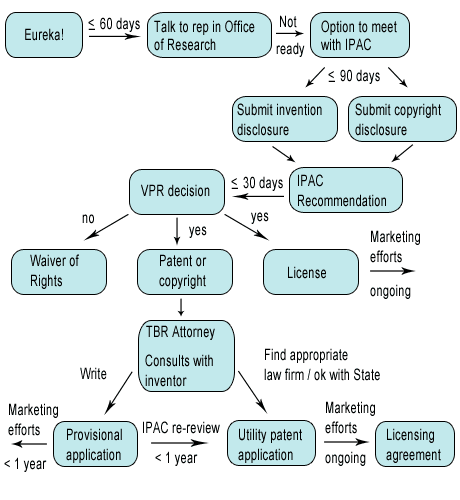What is Intellectual Property?
Intellectual property is a broad term that includes all creative works. Inventions and other works and/or ideas as expressed in a form that can be shared qualify as IP, and these can be protected from unauthorized use as patents, copyrights, trademarks, or trade secrets.
What is Commercialization?
Commercialization of intellectual property involves the transfer of intellectual property from the University to the marketplace through licensing to and/or partnering with existing or newly created companies. This aids in the further development of MTSU technologies and benefits society by generating new and better products that will ultimately improve the quality of life.
I’ve got an idea – now what?
First check the criteria for patentable ideas and copyrightable works. If appropriate for patent or copyright, the idea must be disclosed to the University within 60 days of discovery. Do NOT report the invention in the literature or at a conference before disclosure or you may risk losing patent rights. The process for disclosure of intellectual property (IP) at MTSU is summarized in the diagram below and follows MTSU IP Policy. A faculty, student, or staff member who makes an invention or discovery should discuss it with a representative from the Office of Research and Sponsored Programs to get preliminary answers to questions. A student should first discuss the Invention or Work with his/her instructor, who will provide assistance in initiating further discussion within the University. Make sure that the dates of critical discoveries and data concerning the invention are well documented! If the invention is developed enough to write up, the next step is to complete an invention disclosure form or copyright disclosure form. Submit an electronic copy to the Office of Research and Sponsored Programs via research@mtsu.edu or (Ingram Building, Garden Level, x5005). It will be added to the agenda for consideration at the next Intellectual Property Advisory Committee (IPAC) meeting. The committee meets monthly, or at least once per semester, as needed. If your idea is only in the first stages of development, the IPAC can provide guidance and support (or reference to an appropriate mentor).
Process for Disclosure of Intellectual Property (IP)
What is the purpose of disclosure?
First of all, disclosure of inventions or works including scholarly works is required. According to MTSU policy, disclosure is required within 60 days of discovery. If the invention is made as a result of a federally sponsored project, federal law (Bayh-Dole Act) requires disclosure, and the University is given the right to patent, copyright, and/or commercialize inventions and works. Aside from complying with requirements, inventors and authors will share any profits from the IP with the University after patent or copyright costs are recovered. The University will consider assuming the risk and considerable costs of patent application, marketing, and/or licensing of inventions or works disclosed.
What is the scope of patentable inventions?
According to the United States Patent and Trademark Office (USPTO), patents may be issued for inventions that are novel, non-obvious, adequately described to allow one of ordinary skill in the art to make and use the invention, and claimed by the inventor in clear and definite terms. Patentable inventions include: process, machine, article of manufacture, composition of matter, and improvement of the preceding items. Such patents are defined as Utility Patents. Items that cannot be patented include laws of nature, physical phenomena, abstract ideas, literary/dramatic/musical/artistic works (which can be copyright protected.) More information is available at www.uspto.gov.
What is copyrightable?
According the Copyright Office, copyright law protects the authors of “original works of authorship, including literary, dramatic, musical, artistic, and certain other intellectual works.” This protection covers both published and unpublished works, regardless of the nationality or domicile of the author. Copyright law grants copyright holders, such as publishers, writers and other types of creators, the exclusive right to reproduce, perform, distribute, translate and publicly display their original works. Copyright is automatic when a work is written or recorded, but registration, as well as more information about copyright, can be obtained at www.copyright.gov.
What is the advantage of patenting or copyrighting?
Both patents and copyrights allow the inventor or author exclusive rights to commercialize the invention or work, respectively. This means you can make money by selling, licensing, or pursuing commercialization of your idea! If the University is willing to take on the cost of patenting and or support of commercialization, you can avoid the risk, while sharing in the profits. The University shares profits with the inventor or author after the costs of IP development and protection have been recovered.
What is the IPAC?
The Intellectual Property Advisory Committee is a group of faculty and staff appointed by the President that meets regularly to provide input on decisions about whether or not to proceed with patent or copyright protection and/or commercialization at University expense.
What does the IPAC do?
The IPAC reviews each written disclosure and can provide a sounding board for ideas that have not been fully developed. The inventor or a representative is allowed to examine all written materials submitted to the Committee in connection with the disclosure and, upon request, make an oral presentation to the Committee concerning the merit of the invention and its commercial potential. The Committee will recommend action on the invention or work to the designee of the President, taking into account the best interest of the University, the inventor, the sponsor (if any) and the public.
How long will the review process take?
Typically, the IPAC will review each written disclosure during the meeting in the month it is received and make recommendations. Often, the inventor is requested to provide more information to the committee in time for the subsequent IPAC meeting. Therefore, to expedite the process, it is best to provide a clear and complete description of the invention or work in the disclosure and do a thorough literature search to find similar inventions. After the IPAC is satisfied that there is enough information to make a decision about further action on the IP, it will make a recommendation to the designee of the President. The inventor or author will be included in communications regarding University decisions.
What happens after the IPAC review?
Once the IPAC makes recommendations, the Vice Provost for Research (designee of the President) makes a decision whether or not the University should retain rights to the intellectual property. If rights are retained, the inventor may work with the TBR counsel, another attorney, or a university representative to write an application for a provisional patent (protection for 1 year) and/or full patent protection at University expense.
When does the University own the IP?
The University generally owns IP created by employees. If the University pursues (and pays for) patent or copyright protection on behalf of the inventor or author, patents and copyrights belong to the University. Any profits realized from commercialization of the IP will be shared with the inventor or author.
When does the Author or Inventor own the IP?
If the University decides not to pursue protection and/or commercialization of the IP, the inventor or author may request rights. The inventor may then choose to pursue patent protection and/or commercialization on his/her own. Be advised that patent costs often exceed $20,000 over the life of the patent (20 years), mostly due to attorney fees incurred within the first few years.
How long will the patent process take?
Within one year after the date of disclosure the University will either file a patent application for an invention, choose to license the invention, or release the invention or work in writing to the inventor or author, with the permission of the sponsor, if any. The inventor will be updated regularly at the key points in this process, as indicated in the diagram. If patent protection is pursued, the first reply from the USPTO is not expected for 12-14 months after filing. However, the University will take action to market IP as soon as a patent or copyright is filed. The inventor will be notified about progress at the end of each semester, if not more often.
When do marketing efforts on IP take place?
In most cases, the University would like to recover or defer patenting costs to a company that is interested in commercializing the IP. Therefore, efforts to interest the commercial sector in the idea will begin once the provisional or full patent is sent to the USPTO. The diagram below illustrates the options.



